
FLAMINGO BREEDING SEASON ON INAGUA, BAHAMAS with MELISSA MAURA
Flamingos. The national bird of the Bahamas, featured in the nation’s Coat of Arms. But sadly no longer available to view on Abaco**, despite sporadic attempts to reintroduce them as breeding birds on the island (the last, I believe, about 15 years ago). By the end of the c19, numbers were already small. During his field trip in 1886, naturalist F.H.Herrick noted “The rare flamingo is now reduced to a colony of a few hundred on Abaco, where, as I was informed by an old settler, they numbered thousands several years ago, and similarly the beautiful tropic bird, which is hunted chiefly for food, is being gradually exterminated”.
Ornithologist Charles Cory noted none on his visit to Abaco in 1891 (though he does seem to have been concentrating on smaller birds). In 1905, naturalist Glover M. Allen reported his Abaco findings in THE AUK Magazine, which I have summarised elsewhere: “Of particular interest is… the apparently imminent loss of the flamingo (“fillymingo”) from the Northern Bahamas – a single colony only still surviving on the Abaco Marls by 1905″. There remained a breeding population on the Abaco Marls until the mid-c20, but they then appear simply to have died out there (and more generally in the northern Bahamas).
So to see these gorgeous birds, you will have to go elsewhere. Inagua, to be precise, where in the INAGUA NATIONAL PARK you will find the world’s largest West Indian flamingo colony (around 50,000 of them). Melissa Maura, whose superb photos of ABACO PARROTS I recently featured, visited Inagua during the 2012 breeding season, and took some wonderful photographs that she has kindly allowed me to use. They certainly deserve wider publicity. The collection below (©Melissa) shows adults in flight; adults standing around; the remarkable cup nests; and this year’s chicks… overall, a gallery of 50 shades of pink and grey…
** For the second time this week, nature has outshone mere bloggery. First, I wondered when a manatee might visit Abaco. Answer: right now! Georgie has taken her first long trip from her new home on the Berry Is to visit Abaco – see HERE. And now Sean Giery has responded to a link to this flamingo post on the excellent ABACO SCIENTIST website to say “I just saw my first flamingo last week flying over the beach at Crossing Rocks. It would be great to see them make a comeback on Abaco”. That’s a wonderful prospect.
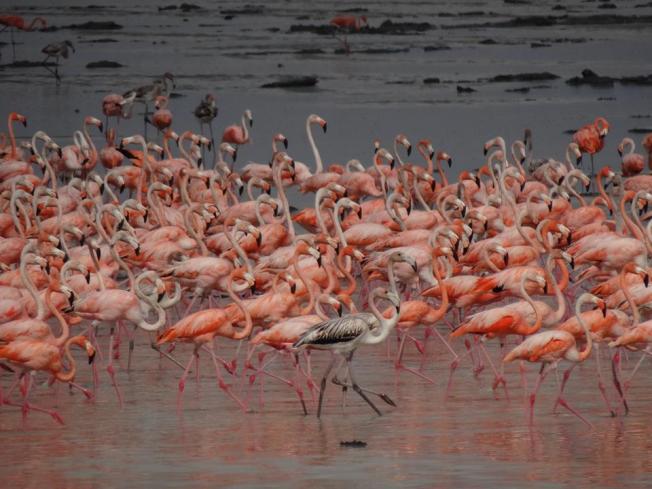
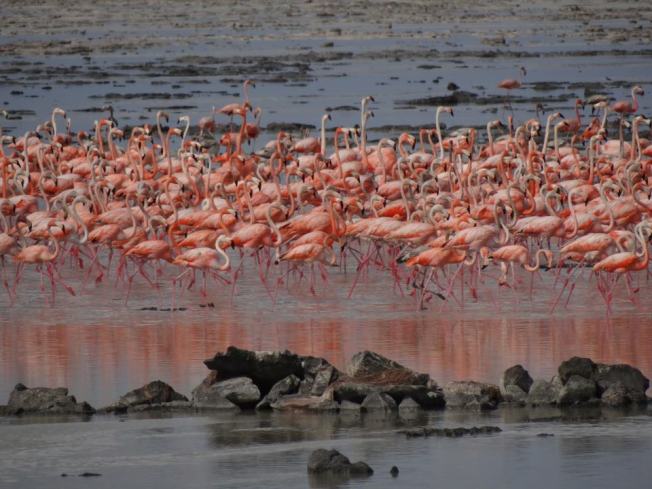

A brief clip of the sound of Caribbean Flamingos
[audio http://www.birdforum.net/opus/images/b/b8/Phoenicopterus_ruber_%28song%29.mp3]
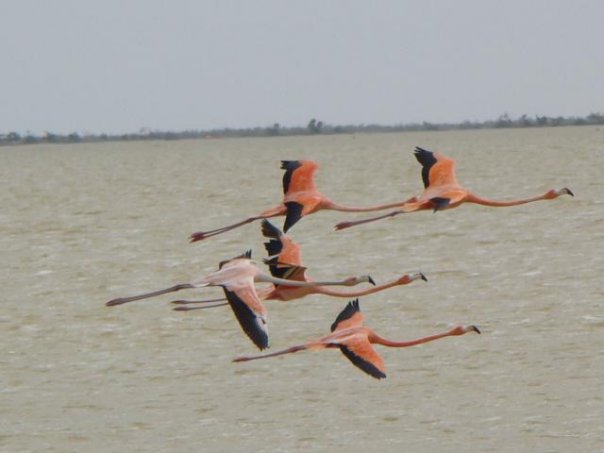











Please note: these photos are © Melissa Maura; please contact me if you want to use any of them…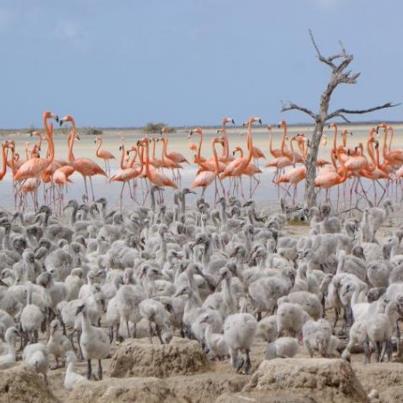

WEST INDIAN FLAMINGO Phoenicopterus ruber (BNT Article)
DESCRIPTION
The West Indian Flamingo is hardly one to get confused with other birds. Its long legs, long neck and characteristic pink colour make these birds like no other. The West Indian Flamingo has a large, heavy, down curved bill that is most often described by the layperson as “strange”. Adults can reach up to five feet in height.
HABITAT
Even though the Flamingo is a strong flier, it is really quite shy and prefers to live in remote and lonely places. Usually these are rather desert-like spots, dry islands and shorelines where salt is made, and where few other creatures can survive. The island of Great Inagua fits that portfolio perfectly. This is where the majority of West Indian Flamingos are found in The Bahamas. The flock breeds around Lake Windsor (Rosa) which lies within the boundaries of Inagua National Park.
DISTRIBUTION
The West Indian Flamingo which once roamed the entire neo-tropical region (tropical Americas) was hunted to a near extinction. Today the West Indian Flamingo is mostly found on the island of Great Inagua in the Bahamas but has also recolonized islands in the Bahamas such as Mayaguana, Crooked and Acklin islands, Exumas, Long Island and Andros.The West Indian Flamingo has also recolonized other countries such as Aruba; Brazil; Colombia; Cuba; Dominican Republic; Ecuador; French Guiana; Guyana; Haiti; Jamaica; Mexico; Netherlands Antilles; Suriname; Trinidad and Tobago; Turks and Caicos Islands; United States and Venezuela.
DIET
Flamingos are filter feeders and feed on the microscopic plants and animals found in ponds and mud. The larvae of the salt marsh fly is one of the major constituents of the diet of West Indian Flamingos. They also eat brine shrimp, small snails as well as other forms of animal and vegetable life so small that they can scarcely be seen without the aid of a microscope! Although small in size, this food is rich in a protein called beta-carotene which gives Flamingos their characteristic colour. Flamingos stir up their food from shallow water and separate it from the mud and water by pumping and straining it through their bill. They are the only birds which feed with their bill upside down!
REPRODUCTION
Flamingo breeding activity usually begins in early March when huge flocks gather and engage in elaborate and loud courtship displays. This is almost like a very large dance – the massed birds parade together shoulder to shoulder, preforming head flagging (waving the head from side to side), wing salutes (opening the wings to expose the black flight feathers) and the twist preen (twisting the neck over the back and pretending to preen itself whilst stretching out on of its wings. The chorus of courting birds can be heard miles away. This synchronized courtship dance stimulates the birds to breed at the same time, ensuring that the chicks are hatched around the same time.
When the courtship displays are all over the pairs are formed and the building of the nest mounds begins usually around April. Nests are built on the ground out of mud and are baked hard by the sun. The nest which resembles small volcanoes, can be from a few inches high to sometimes over two feet high a shallow crater at the top. This is where the single egg is deposited. Flamingos lay one white egg that is about twice the size of a hen’s egg. Both parents share in incubation which takes exactly 28 days to hatch.
Flamingo chicks look nothing like their parents. They are covered with a thick coat of white down and have pink bills and feet. Both parents feed the chick a secretion from the crop gland in the neck known as “flamingo milk” or “crop milk”. This “milk” is a concentration of fats and proteins (similar to mammals milk) and has a very high amount of beta-carotene making it a bright red colour. When they are about 30 days old the chicks have changed to a dark gray down and start to feed themselves but still eat from their parents if they can. By three months the chicks are fully grown and become a bright pink colour signalling that they are sexually mature to the rest of the colony.
STATUS
In the 1950’s it was thought that was hunted down to a small population of about 5,000 only on the island of Inagua, Bahamas. With the help of the National Audubon Society in the United States, the creation of the Bahamas National Trust and the appointment of park wardens, the Inagua population grew to approximately 60,000 – a true conservation success story. It also became illegal to harm or capture this bird under the Bahamas Wild Bird (Protection) Act. The IUCN redlist of threatened species lists the West Indian Flamingo as a species of Least Concern due to the fact that the population is currently expanding and increasing its range. However, The Convention on the International Trade of Endangered Species (CITES) lists the West Indian Flamingo in Appendix II which limits the exportation of the species as it can cause the species to become endangered.
THREATS
Natural threats: Building nests directly on the ground make Flamingos vulnerable to a number of predators. The eggs can be trampled by wild donkeys and boar that roam freely in the same area where Flamingos live and nest.
Hunting: As flamingos only bare one chick a year, it makes them vulnerable to over exploitation. Although Flamingo meat is eaten in other Caribbean countries, it is illegal to harm, capture or kill the Flamingo in The Bahamas.
Historical Threats: The Flamingo was hunted for its big, pink feathers that were used to decorate hats and other nonessential items. Low flying planes of World War II over Andros wreaked havoc on the Flamingo population. This noisy disturbance drove these shy birds away- so much so that their return was doubtful.
INTERESTING FACTS
The Flamingo is the national bird of The Bahamas.
The West Indian Flamingo is also refered to as the American, Caribbean or Rosey Flamingo.
There are a total of 6 species of flamingos in the world. The other species are Andean Flamingo (Phoenicoparrus andinus), Chilean Flamingo (Phoenicopterus chilensis), Greater Flamingo (Phoenicopterus roseus), Lesser Flamingo (Phoeniconaias minor), Puna (James’s) Flamingo (Phoenicoparrus jamesi).
The Greater Flamingo is closest related to the West Indian Flamingo. Despite the Greater Flamingo being a larger size and considerably less brightly coloured, some authorities consider them the same species but different sub-species.


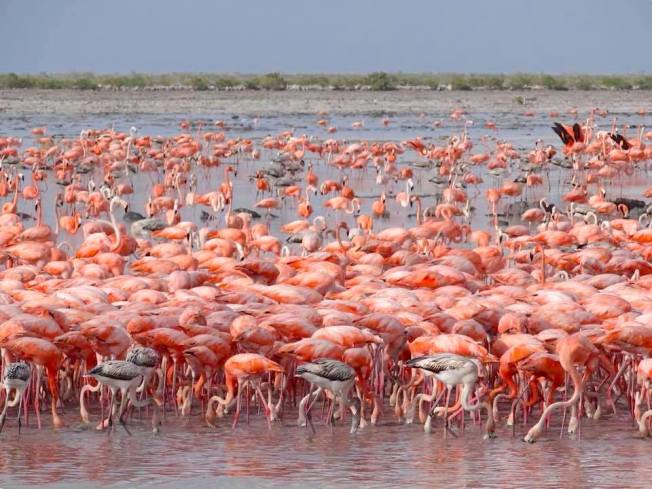




































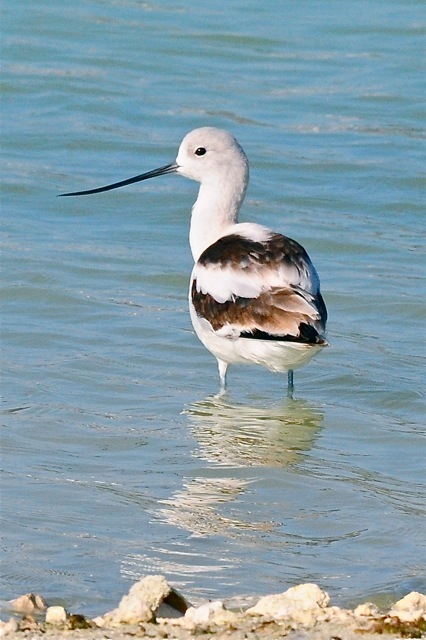




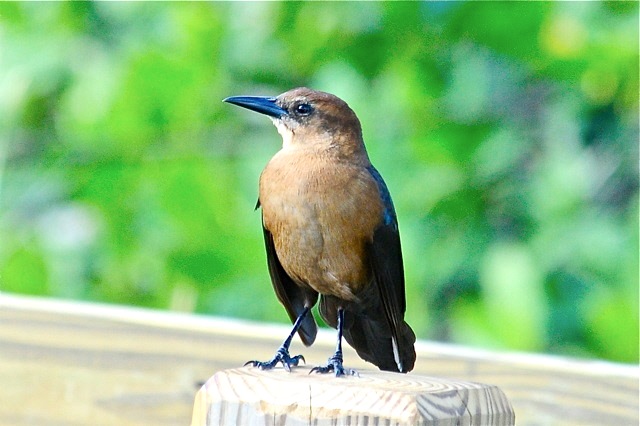

























You must be logged in to post a comment.